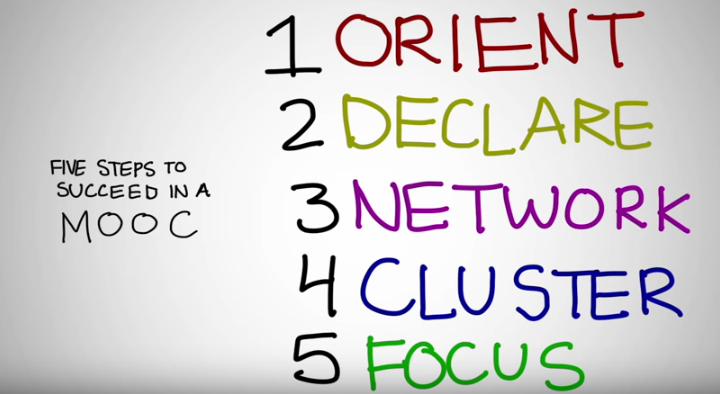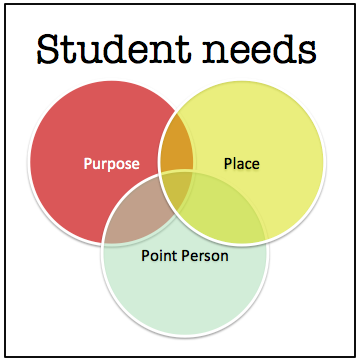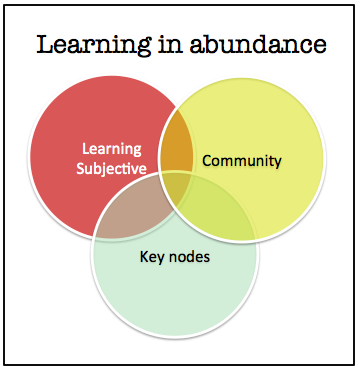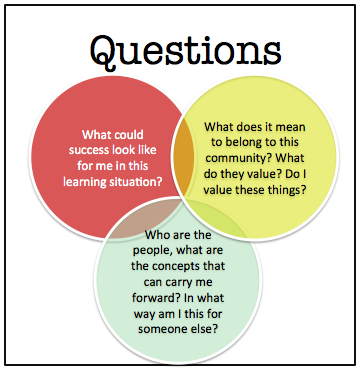Sometimes ideas come from unexpected places.
A recent paper entitled “The rhizome: A problematic metaphor for teaching and learning in a MOOC” caught my attention. It critiques Rhizomatic learning and the rhizo MOOC #rhizo14 in particular. It wasn’t easy to read, but one point about vulnerability stuck out for me, and resonated as something that needs thinking through in all learning contexts.
“I think we do need to notice that a new sort of resilience needs to be nurtured.”
It stuck with me. I’ve kind of taken it as an injunction. I wish I knew who had said it, because I have a pile of thanks to offer that person. We DO need to notice it. I’ve written two posts earlier this year dealing with the idea of resilience as it relates to two different educational contexts – students moving from one educational context to another and my own attempts to learn new things. I will sidestep (for now) the question of whether the resilience required is ‘new’ or not, but I’ve been playing with a model of what that internal narrative of resilience could look like for someone learning on the web. I was going to say ‘open web’ but the near ubiquity of spaces like Facebook, which are distinctly not open, require their inclusion as the vast majority of people who will be learning online will at some point end up in one of these corporate learning spaces.
What I’ve been working with so far
In 2010 George Siemens, Bonnie Stewart, Sandy MacAuley and I did a SSHRC funded research grant on the (at that time) new concepts emerging around MOOCs. One of the central questions we had asked ourselves was about the patterns that we could find that lead to success in a MOOC.

Six years later I’m still broadly comfortable with this as the external process by which someone starts to learn and succeed online. Whether someone goes ahead and makes it all the way to focus/outcomes part of this process is up to them and the process need not really be this linear. Overall, though, I’m still happy with it. We need to Orient ourselves, get a sense of what is going on, what the general rules of engagement are. We need to Declare who we are, need to have a place for our identity to stand. We need to Network with others. We need to find people who we can work with and Cluster with them. Then we can, if we wish, Focus on some sort of outcome, though i feel less strongly about this as a necessity.
What this doesn’t account for
But that’s all external. That’s what it looks like while/after it’s being done. How do we, as Kate so elegantly puts it – “support students to propose their own narrative of purpose”?
@markdrechsler @davecormier @MarciaDevlin We can support students to propose their own narrative of purpose, not just mould them to ours.
— Kate Bowles (@KateMfD) March 30, 2016
As our injunction dictates, we need to account for the resilience required to confront the learning process without the safe structures and comforting space of a ‘learning objective’ or a teacher telling you you’ve done it right. We need to acknowledge that learning in a network/community/wild space means that sometimes there will be uncontrollable interactions. You will be confronted by what a colleague today referred to as ‘aggressive academic hectoring’. There is privilege always. How do we maintain the advantages of rhizomatic space and still give people the tools to be resilient?
A new model
In my last post, I presented a model for how we can talk about resilience for a student in terms of how they might fit in a university. The model is meant to be both an emotional guidepost for students new and old and a reminder to those of us supporting them of what our goals are.

It’s occurred to me that the same thinking process might be useful here. If we translate some of the language closer to what we’ve been exploring with regards to learning in a world of abundance, we might get something like this. The idea of ‘purpose’ matches up for me with ‘learning subjectives‘ which we were exploring last year – Designing for when you don’t know where you’re going. The sense of place feels very comfortable as community. The third one is interesting… every student examplar we’ve found for resilience and much of the research suggests that ‘a person of somekind’ (as opposed to lots of people) is super-important.

I’m still just mulling this over, so I’m not going to go to far with this. The learning subjective is the thought, idea, need… the thing that got you started into this and your constantly reassessed perspective on it. It’s different from an outcome/objective in that you don’t know where it’s going. More importantly, no hierarchically approved agent has decided that it is the the ‘thing you need to know’. The community is the place where thinking resides. There are healthy communities and unhealthy communities. It’s not a perfect situation… it’s the discourse on the thing that you are interested in. The big difference now is that this discourse can be had with living people instead of the thoughts of living/dead people printed on dead paper. The narrowed perspective and finalized thoughts of the text are replaced with the uncertainty of the community space. The key nodes are thoughts/people/things that you start to see as guideposts along the road. They are ideas/people that you can turn to for direction, for help, to find out where help is.
Process of resilience
In accord with the Viv Rolfe quote in the last post, we want to think of resilience as a process rather than some innate quality that people have. This model then, is a suggested process that might help folks who are trying to engage in learning when there are an indefinite number of options/connections/approaches/solutions to the things they are interested in. When that thing they are involved in is simple (like a location on a map) or complicated (like a recipe) this is not such a big issue. If they are engaged in learning something complex this sense of resilience becomes more important.

Moving forward with a model
Is it useful to have a model like this? What questions should be in the circles? How can we introduce people to the process of re-examining their own subjectives, the community of learning (the curriculum) they are approaching and the key people and concepts in it? Resilience in the sense of enduring adversity successfully only works when we know what ‘success’ looks like. In a world of abundance, the learner needs to constantly evaluate what they want, what knowing looks like (the community) and reassess their touch points.
learning in abundance is well explained… I think it is very critical especially for distributed, networked learning spaces…
I am pausing here at the key nodes concept and realizing ways in which such nodes sustained me early on in my connecting and later how I became that for other people. I think folks who don’t normally learn in abundance think of it as overwhelming but it doesn’t need to be as long as u have key nodes (ppl or things) to focus on or fall back on. If I were to add something here it would be…how do we nurture key nodes and help newbies find them? Do we need the node go signal “I am here for you” or the newbie to signal “I need help” or something more subtle? During ccourses we kinda tried something like that. At my university we are considering mentoring betw fac and students. But we sense these things develop organically f2f (more naturally and easily for some and not others). It’s similar but more complex and requires more intentionality and perceptivity online…what do you think?
I am glad that you read our paper Dave, and valued a quote from a survey respondent . In the conclusions, we said “Use of the rhizome metaphor for designing teaching and learning experiences necessitates consideration of distribution of power in smooth space and the fragility of the will to learn (Barnett, 2007).” I think that the context of resilience is important as well as the process. I have started to play with a different idea of fragility and resilience of the institutional context here https://francesbell.wordpress.com/2016/04/02/institutional-fragility-and-resilience/ and would also like to think about a similar idea of fragility within networks/ communities.
Thanks for the comment. I enjoyed your post. Weve been exploring the use of words like ‘point person’ and ‘key node’ to replace words like mentor. Still not happy with them. The hierarchical habits of generations are difficult to shed. But my own experience and the stories weve been collecting from students seem to indicate a difference between the context of community and the nature of the individual relation between people/people people/ideas
@maha Yeah. that relationship and what it means is what I keep thinking about.
I worry about the terms “key nodes” and “point people” it is a short step to “corporal” to “capo”.
Resilience as concept and process worries me too.
I have memories of resilience (character) building: cold showers, long runs, beating, humiliation.
Are we talking of individual resilience, cultural resilience or systemic resilience?
Are individuals, communities, fragilised to such an extent that we are now focussing on “enabling resilience”?
Resilience as regards what/who?
Do we fragilise so to better manipulate resilience?
Fragile to what sort of attack?
The term “abundance” is equally worrying.
“In a world of abundance…or poverty?”
I’m also worried about the language. Broadly speaking the shift i’m thinking about is away from ‘resilience as something I train you to be by making you run for a long time’ to being a process that everyone has to work out for themselves. Broadly speaking, I think the big missing gap is that often people think about learning without coming up with their own goals for that learning process… they just adopt the existing one… whatever it may be. A better PROCESS (see… this is resilience as a process) is to think of (re)evaluating your goals (subjectives whatevs) as a regular part of learning. The PROCESS of looking into the community and the PROCESS of finding (insert better word for key nodes) are also things that people should consider doing regularly. The fragility here is wholly dependent on each individual.
I agree with the key being PROCESS. I find myself in conversations on education where my response is often “process.” We can get stuck on content, pedagogy, assessment, etc. but in the end it comes down to process. In my work as a project-based learning coach, a hurdle I often face with educators is that the PRODUCT is not what matters most, but rather the PROCESS. If the process is sound, what comes out as the product will also be sound. Many (all?) design thinking principles apply here.
Glad to hear you are worried by the language Dave.
I have started taking a look at it.
Resilience or resistance.
http://tachesdesens.blogspot.fr/2016/04/resilience-or-resistance.html
PS. I don’t for one moment believe that “fragility is wholly dependent on each individual.” Saying that is opening up a whole can of worms.
Yes it is.
Could you believe that fragility could be partly dependent on each individual?
More food for thought – thank you Dave. I’m interested in your first paragraph and have been thinking about academia on the web and how the nature of criticism/criticality has changed. I remember going to conferences during my PhD and break out arguments in the auditorium were common place. I wonder why I feel more vulnerable now if people are critical of me through social media? We aren’t robust and critical in our research anymore with much of it generally ropey and subject to bias. If we can’t take some criticism on the chin, I’m not sure how we are going to advance what we do?
Now look what you’ve done. You’ve set me off on something else. But thank you for your inspirational words.
I really like those questions – I think they get to the heart of something… and this idea of resilience as a process is sustaining 🙂
To me, resilience is about surviving intact.
I think my concept of resilience has been stained by my readings in complexity sciences which seem to define resilience as the ability of a system to cope with and recover from internal and external perturbations that threaten to disrupt the structures and processes that define the system, which give the system its functional identity and capacities. If I start here, then I find myself having issues with some of the things I’ve read so far.
First, all that I’ve read so far seems to put a mostly positive spin on resilience, whether as a personal trait or as a process of negotiating a complex space. Resilience is something that’s good to have, to learn, or to do. However, this seems to ignore the value of the system being preserved. As near as I can tell, organized crime, poverty, ignorance, fascism, terrorism, influenza, cancer, and academic hectoring are all amazingly resilient systems. Perhaps we can study those systems and learn how to mimic their amazing resilience in systems we want to preserve, such as students, and to undermine the resilience of those systems we want to change or eliminate. Anyway, it may be useful to ask in what contexts is resilience positive, negative, or neutral. If ignorance is a resilient system, then in some ways, the purpose of education is to overcome that resilience. Plagiarism is a resilient system. Hmm …
Then, most of the assumptions seem to be that resilience is about coping with external perturbations. I think internal perturbations are also part of the mix. Resilience in a well-functioning system however defined—a student, for instance—must cope with forces within and without the system that threaten to undermine the system. Moreover, the system must cope with the exchanges, the feedback loops, between inside and outside across whatever boundaries help define the system. New college students have internal forces at work that cannot be ignored, especially when entering into feedback loops with an institution’s external forces.
My sense is that there is much for us all to say about resilience, and I really look forward to the conversation. Let’s see if this conversation will be as resilient as Rhizo has been.
Dang … you people have me thinking again …
They have a bad habit of that.